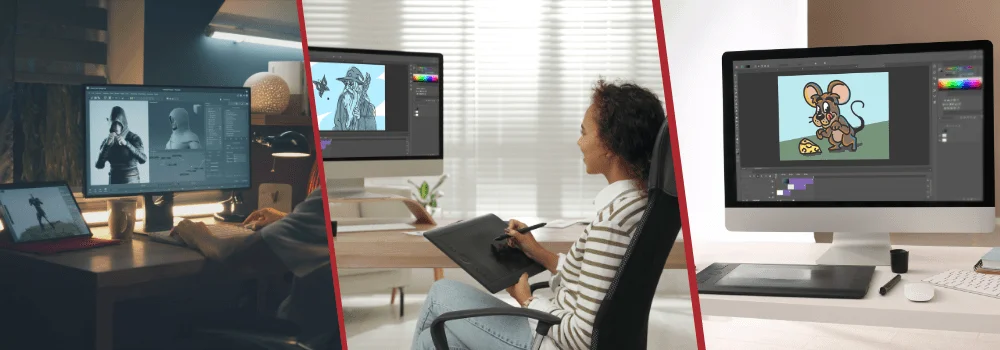How to Become an Animator?
Transform Your Imagination: Step-by-Step Guide to Becoming an Animator

In this Career Outline

Introduction to Animator
"Animation is not the art of drawings that move but the art of movements that are drawn." - Norman McLaren
Imagine a world where your sketches come to life, characters breathe and move, and stories unfold in vibrant, dynamic visuals. Animation is the magical craft that turns imagination into reality. Whether it's the heartwarming charm of Pixar movies, the intricate detail of anime, or the captivating graphics in video games, animators are the creative force behind these experiences. If you’ve ever thought about starting this exciting journey, you’re in the right place. Let’s explore the path to becoming an animator and making your mark in this fantastical world.
Steps to Become an Animator:
Becoming an animator involves a journey where creativity, technical skills, and passion come together. Here’s a roadmap to guide you:
Step-1
Start by immersing yourself in the world of animation. Watch various styles of animated movies, TV shows, and video games. Study the work of famous animators and identify what excites you the most.
Step-2
Traditional drawing skills are the foundation of animation. Practice sketching regularly to improve your understanding of proportions, movement, and expressions.
Step-3
Pursue a formal education in animation. Many institutions offer specialized degrees in animation, where you can learn about character design, storyboarding, and the principles of motion.
Step-4
Familiarize yourself with industry-standard software like Adobe Animate, Autodesk Maya, and Blender. These tools are essential for creating both 2D and 3D animations.
Step-5
Your portfolio is your showcase. Include a variety of projects that demonstrate your skills in different aspects of animation, from character development to complete animated sequences.
Step-6
Attend animation workshops, join online forums, and connect with professionals in the industry. Building a network can lead to valuable internships and job opportunities.
Step-7
The animation industry is constantly evolving. Stay current with the latest trends, techniques, and technologies to keep your skills relevant.
Eligibility Criteria
| Eligibility Criteria | Description |
|---|---|
| Eligibility | At least 50% aggregate in 10+2 examinations |
| Educational Background | High school diploma or equivalent. |
| Undergraduate Degree | Bachelor's degree in Animation, Visual Arts, or a similar discipline. |
| Postgraduate Degree | Optional but beneficial – Master's degree in Animation or specialized fields like VFX, Game Design, etc. |
| Entrance Exams | Some institutes may require portfolio reviews or specific entrance exams for admission to animation programs. |
- Must possess at least 50% aggregate from a recognized institution in 12th, from any board PUC/CBSE/ICSE/ISC, etc. However, the cut-off margin varies with the selection process of different colleges.
- A Bachelor's degree in any field can be beneficial, but a degree in English and Communication can provide a more effective reach in helping you connect with your clients.
- There are no entrance exams after 12th conducted to validate the performance of Animation. Entrance exams solely depend on the requirements of the University/College.
- One must acquire a degree/diploma or certification in a recognized establishment to become an Animator. This is a basic qualification you must require to enroll in this line of work.
- An M.A. in Art & Design can also prove to be helpful while looking for a higher degree and extensive learning.

Not eligible to pursue this career?
Find out different career options based on your current academic accomplishments. Enquire with our career experts and build a roadmap to your career success!
Tasks to perform as an Animator:
Knowledge & Skills Required
Animator needs a diverse skill set to thrive in their roles. Here are the crucial areas of knowledge and key skills required for success in this field:
| Knowledge Required | |
|---|---|
| Understanding the principles of movement, timing, and storytelling. | Basics of filmmaking, including storyboarding and editing. |
| Expertise in tools like Adobe Animate, Maya, Blender, etc. | Fundamentals of drawing, color theory, and composition. |
| Skills Required | |
|---|---|
| Creativity | Collaboration |
| Attention to Detail | Technical Proficiency |
| Strategic Thinking | Time Management |

The Knowlegde and Skills don't intrigue you?
Your career may not align with your interests. Identify them and match with careers requiring those skills for faster growth and success!
Job roles offered for an Animator:
Once you procure the required qualifications for becoming an Animator, a myriad of options are open to you. There are multiple projects you can undertake throughout this line of work, and there are many other fields you can branch out to as well.
Multimedia artists create stunning digital content for films, games, websites, and advertisements. Using a mix of technology and creativity, they design graphics, features, and storyboards. Typically, they hold a bachelor’s degree in fields like graphic design or animation. To showcase their talents, they compile portfolios during their studies. Their work involves combining text, images, and sound to tell stories and create immersive experiences.
Interior design directors oversee the aesthetic and functional aspects of indoor spaces. They create and refine design plans, ensuring they meet safety regulations and client needs. With expertise in interior construction, they select and maintain furniture and decor. Their role includes inspecting sites and verifying that designs are executed correctly. They provide critical recommendations throughout the project to achieve the desired results.
Illustrators use images to convey messages more effectively than words alone. They start with sketches and refine them into detailed drawings, either by hand or digitally. Their work often supports or enhances written content or stands alone to simplify complex ideas. Illustrators need strong drawing skills and the ability to understand and meet client expectations, making necessary revisions until the final design is perfect.
Graphic designers communicate ideas visually, combining art and technology. They create designs for ads, brochures, magazines, and corporate reports. Their process begins with sketches or digital drafts, using tools to blend images, text, and animations. Graphic designers work closely with clients and other team members to ensure their designs accurately convey the intended message and meet visual standards.
Product designers focus on the look and functionality of commercial products. They enhance existing designs and evaluate competitors’ products to ensure their creations are both durable and user-friendly. Often progressing to higher roles in their careers, product designers benefit from strong research skills and an understanding of market trends. Their job requires long hours of computer-based work, necessitating comfort with extended periods of sitting.

Not sure where you fit in?
With countless career options, choosing the right path can be tough. Analysis and guidance sessions help clarify what to study, pursue, and achieve.
Career opportunities in Animator:
Animators can opt for various fields of work in the companies listed below:
| EY | Target | Amazon |
| Grey Group | Planet Spark | Zee Entertainment Enterprises Limited |
| InMobi | DaMENSCH | Media.Monks |
| Myntra |
Colleges offering courses in Animator:
Animators can opt for various fields of work in the companies listed below:
| National Institute of Design (NID), Ahmedabad | Whistling Woods International, Mumbai |
| MIT Institute of Design, Pune | Indian Institute of Technology (IIT Bombay), Mumbai |
| Maya Academy of Advanced Cinematics (MAAC), Multiple Locations | Arena Animation, Multiple Locations |
| Frameboxx Animation and Visual Effects, Multiple Locations | ICAT Design & Media College, Chennai, Bangalore, Hyderabad |
| Amity University, Multiple Locations | Asian Academy of Film and Television (AAFT), Noida |
| D.G. Ruparel College of Arts, Science and Commerce, Mumbai | L.S. Raheja School of Art, Mumbai |
| Manipal Academy of Higher Education (MAHE), Manipal | Toonz Academy, Trivandrum |
| Annamalai University, Chidambaram |
End Note
Starting a career in animation is like opening a door to a world where your creativity knows no bounds. With the right education, skills, and passion, you can bring your imaginative worlds to life. Whether you’re just starting or looking for career counselling after graduation, we can help. Ready to begin your animation journey? Connect with our experts at SetMyCareer. We're here to guide you every step of the way to achieve your career goals.
In this Career Outline
You don't fit in as an Animator?
Find out your best suitable career by booking an appointment with our experts
Book nowGet In Touch
No. 14/595, 1st Floor, Nanjappa Reddy Layout, Koramangala 8th Block, Bangalore 560095





